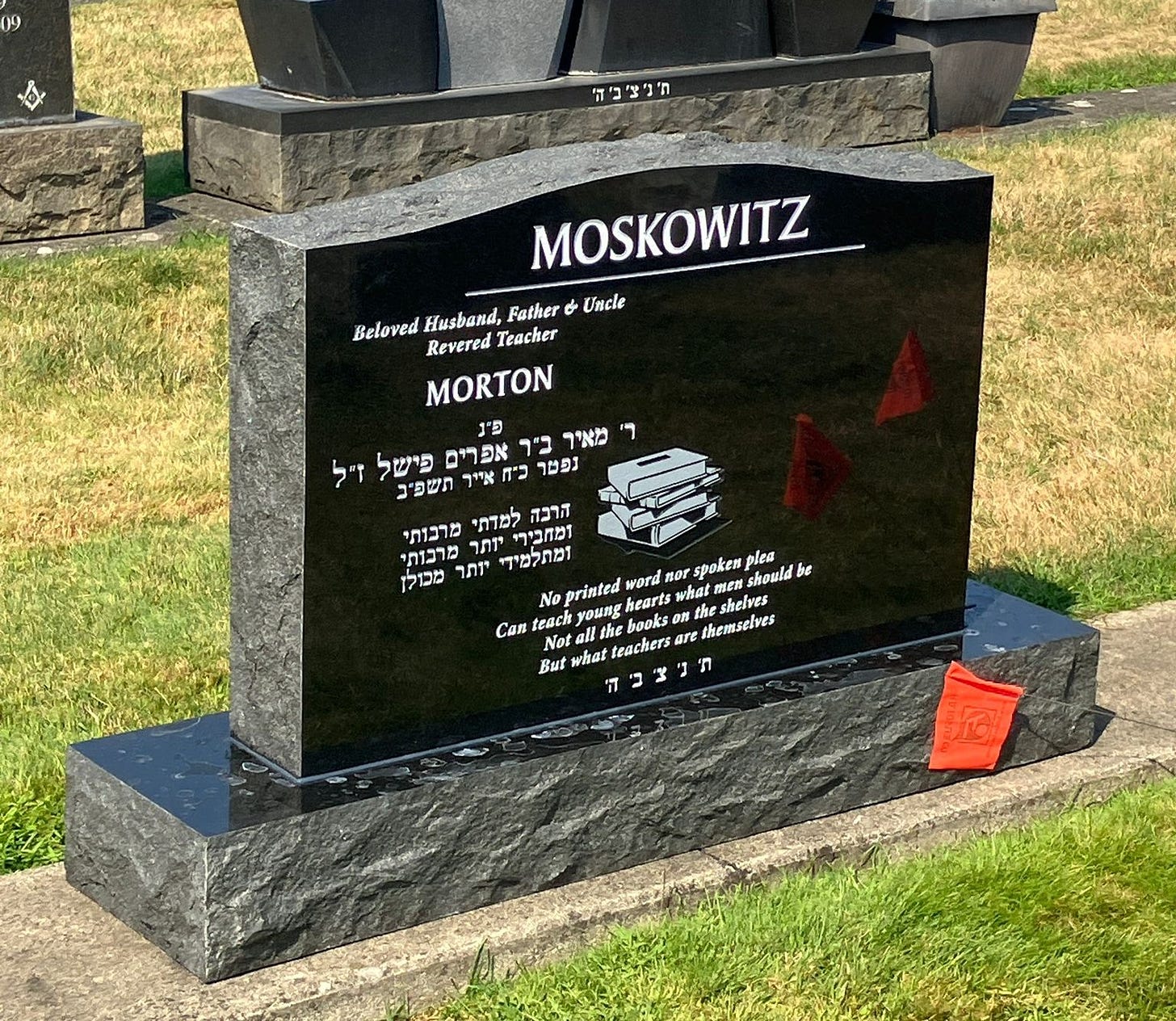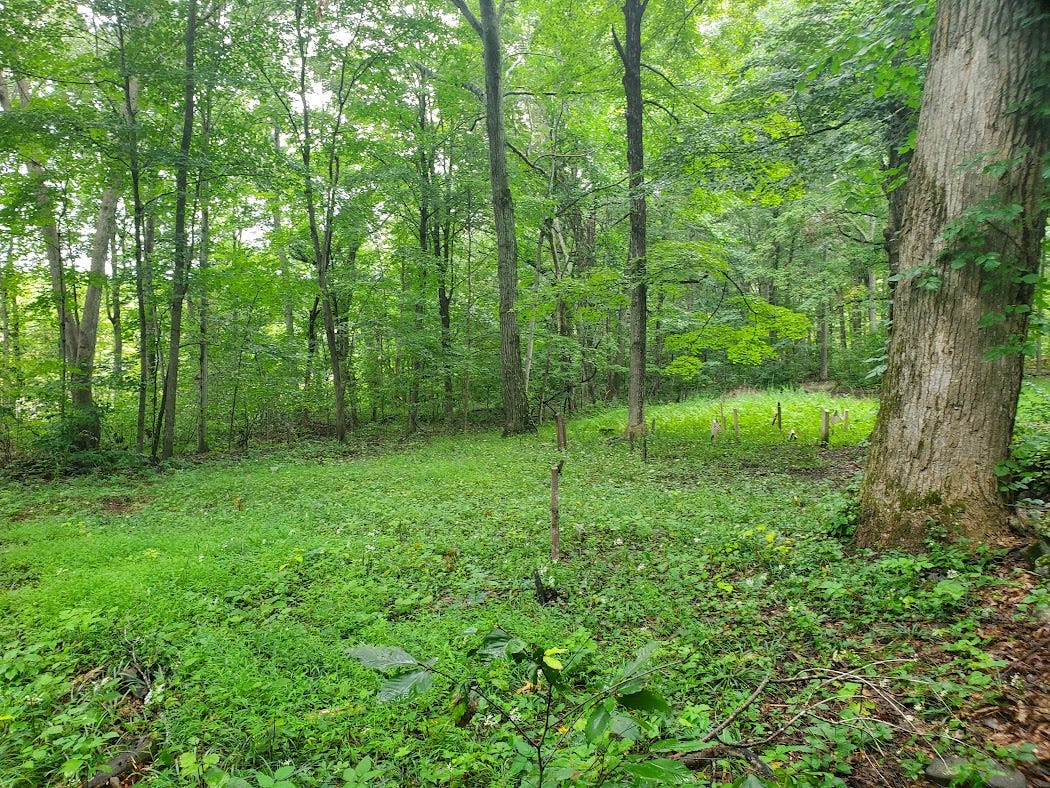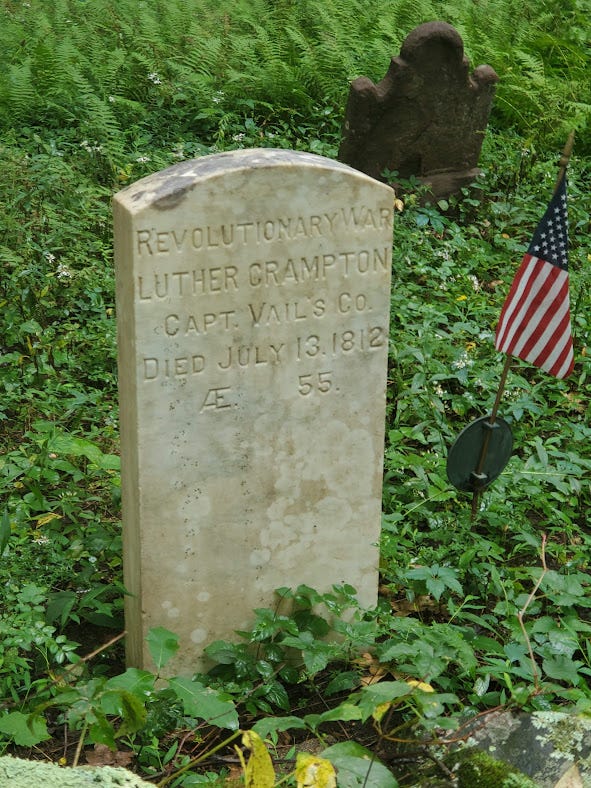Some Thoughts on Rabbi Moskowitz's Unveiling
I was unable to attend the Hakamas Matzeivah (Unveiling) of my rebbi, Rabbi Morton Moskowitz zt"l, but here are my personal thoughts on the inscription and the timing of the event in my own life.
The Torah Content for the month of Elul has been sponsored anonymously in loving memory of Henya bas Tzirel - a mother who cared deeply about her children's engagement with Judaism.
Click here for a printer-friendly version of this article.
Some Thoughts on Rabbi Moskowitz's Unveiling
This past Sunday (8/27/23) was the Hakamas Matzeivah (Unveiling) of my rebbi, Rabbi Moskowitz zt"l. I had the zechus (merit) of helping Mrs. Moskowitz find an appropriate Torah-related inscription, which reads:
הרבה למדתי מרבותי
ומחבירי יותר מרבותי
ומתלמידי יותר מכולן
"I have learned much from my teachers,
and from my friends more than from my teachers,
but from my students the most of all" (Taanis 7a)
We initially tried to find something in Mishlei, but I'm glad we settled on this because I can't think of a more apt statement to capture Rabbi Moskowitz's essence. Even though his favorite definition of "chacham" (wise man) was: "Who is wise? One who sees the consequences" (Tamid 32a), Rabbi Moskowitz epitomized the more well-known definition from the mishnah in Avos: "Who is wise? One who learns from everybody" (Avos 4:1). I’ve never met a single person who was as open to learning from everyone as he.
The statement from Taanis 7a that was chosen for the matzeivah is superior to the mishnah in Avos because it spells out the three main categories of learning relationships in Rabbi Moskowitz's life: teachers, friends, and students. In his case, these categories were fluid. For example, Rabbi Chait started off as his best friend and ultimately became his rebbi. Many of his students eventually became his peers his colleagues. Certain individuals, such as Rabbi Fox, spanned all three categories.
There are multiple variants of the statement in Taanis 7a. The most oft-cited version begins with "I have learned much TORAH." I personally preferred the version which begins with "I have learned much WISDOM" because Rabbi Moskowitz loved ALL wisdom, not just Torah. But I'm happy to see that the final inscription simply states: "I have learned MUCH," since the learning Rabbi Moskowitz sought was unlimited in its scope.
I wasn’t familiar with the English quotation from Kipling — a man whose name I can only hear in Rabbi Moskowitz’s voice as “Ruhd-yahd” — but it is an equally fitting inscription:
No printed word nor spoken plea
Can teach young hearts what men should be
Not all the books on the shelves
But what teachers are themselves.
When I was in graduate school, I came across a statement from Parker J. Palmer who said: "We teach who we are." At the time, I took this to mean that who we are will naturally come out in what and how we teach, no matter what the subject matter is. Only now, upon reading the English inscription on Rabbi Moskowitz's matzeivah, do I realize that it means much more than this. Rabbi Moskowitz fully embodied what he taught. He internalized his ideas, his way of thinking, and his love of learning to such an extent that he and his Torah were one and the same. To simply be in Rabbi Moskowitz presence was to imbibe his Torah.
While I would have loved to be there for the unveiling, I know that the reason for my absence is a better tribute than my presence would have been. I had to be back on the East Coast for the first week of my new high school teaching job. At the time the unveiling took place, I was driving up to Connecticut and preparing to meet my new students. Although I wasn’t able to show kavod (honor) to Rabbi Moskowitz by attending his unveiling, I feel that I am honoring him in the best way I can: by transmitting his teachings to the next generation, sharing the Torah he taught me, and aspiring to become for my own students what he was for me.
(I debated about sharing this last thought because some might find it grim, but I’m going to go ahead and do it.)
This past Wednesday was the beginning-of-the-year retreat at my new high school. We drove to a campsite in southern Connecticut. That afternoon, I joined my new students for archery lessons. At one point, the archery instructor motioned towards the forest and mentioned something about a cemetery. My ears perked up and I asked, “Did you say cemetery?” He said, “Yes. It’s an old cemetery dating back to the 1700s. Many of the graves are worn down, but the ones with the American flag next to them mark veterans of the American Revolution.” Maybe this kind of thing is commonplace for those who grew up in certain parts of the East Coast, but for me, it’s thrilling. I couldn’t believe that there were soldiers of American Revolution buried in this “random” forest next to a “random” Jewish camp. I knew I had to check it out for myself.
I explored the older section of the cemetery looking for the oldest graves I could find. Although I didn’t examine every single headstone, I’m pretty sure that this one has got to be one of the oldest. It belongs to a man named Luther Crampton. He fought under Captain Vial Allen in the Revolutionary War and died in 1812. According to the internet, he was born in 1757, which is 266 years ago.
Although I don’t know for certain, I’m fairly confident that few people ever think about Luther Crampton anymore. It’s only a matter of time before his gravestone becomes as deteriorated and illegible as his neighbors’. I was reminded of the last 90 seconds of Martin Scorsese’s Gangs of New York (2002):
The scene opens with a shot of the rows of corpses left in the wake of the Civil War draft riots. The movie concludes with Leonardo DiCaprio’s character’s voiceover monologue:
My father told me we was all born of blood and tribulation. And so then, too, was our great city. But for those of us what lived and died in them furious days, it was like everything we knew was mightily swept away, and no matter what they did to build this city up again, for the rest of time, it would be like no one even knew we was ever here.
The movie shows the graves of the chief protagonist and antagonist set against the mid-19th century skyline. The movie then flashes forward 60 years, then 60 more years, then 60 more years. By that time, the graves in the foreground are dilapidated and forgotten, and all the people buried there have faded from memory.
Encountering the grave of this forgotten soldier just a few days after the unveiling of my rebbi’s grave gave me pause. How many people will know the name “Morton Moskowitz” in 50 years time? Or 100 or 200 years time? Sadly, not that many.
And yet, the fact that Rabbi Moskowitz won’t be remembered centuries from now does NOT speak to his impact. Just as Luther Crampton did his part in the American Revolution, which altered the fate of this country and the world for the better, the same is true of Rabbi Moskowitz. True, there will come a time one or two hundred years in the future when the name on his headstone is as unrecognized as the names in the cemetery I happened upon, but that’s not what Rabbi Moskowitz was about. His life was dedicated to teaching the ideas in his mind to the students in front of him. He did not aim to leave behind an eternal legacy. He was confident enough in the power of ideas to shape the minds and decisions of those who lived by them, and that was enough for him. The private revolution he initiated in each and every student will carry on and outlive us all.
I would love to hear your thoughts about the inscription and its relation to Rabbi Moskowitz.
Like what you read? Give this article a “like” and share it with a friend! Dislike what you read? Share it anyway to spread the dislike!
Want access to my paid content without actually paying? If you successfully refer enough friends, you can get access to the paid tier for free!
Interested in reading more? Become a free subscriber, or upgrade to a paid subscription for the upcoming exclusive content!
If you've gained from what you've learned here, please consider contributing to my Patreon at www.patreon.com/rabbischneeweiss. Alternatively, if you would like to make a direct contribution to the "Rabbi Schneeweiss Torah Content Fund," my Venmo is @Matt-Schneeweiss, and my Zelle and PayPal are mattschneeweiss at gmail.com. Even a small contribution goes a long way to covering the costs of my podcasts, and will provide me with the financial freedom to produce even more Torah content for you.
If you would like to sponsor a day's or a week's worth of content, or if you are interested in enlisting my services as a teacher or tutor, you can reach me at rabbischneeweiss at gmail.com. Thank you to my listeners for listening, thank you to my readers for reading, and thank you to my supporters for supporting my efforts to make Torah ideas available and accessible to everyone.
-----
Substack: rabbischneeweiss.substack.com/
Patreon: patreon.com/rabbischneeweiss
YouTube: youtube.com/rabbischneeweiss
Instagram: instagram.com/rabbischneeweiss/
"The Stoic Jew" Podcast: thestoicjew.buzzsprout.com
"Machshavah Lab" Podcast: machshavahlab.buzzsprout.com
"The Mishlei Podcast": mishlei.buzzsprout.com
"Rambam Bekius" Podcast: rambambekius.buzzsprout.com
"The Tefilah Podcast": tefilah.buzzsprout.com
Old Blog: kolhaseridim.blogspot.com/
WhatsApp Group: https://chat.whatsapp.com/GEB1EPIAarsELfHWuI2k0H
Amazon Wishlist: amazon.com/hz/wishlist/ls/Y72CSP86S24W?ref_=wl_sharel






